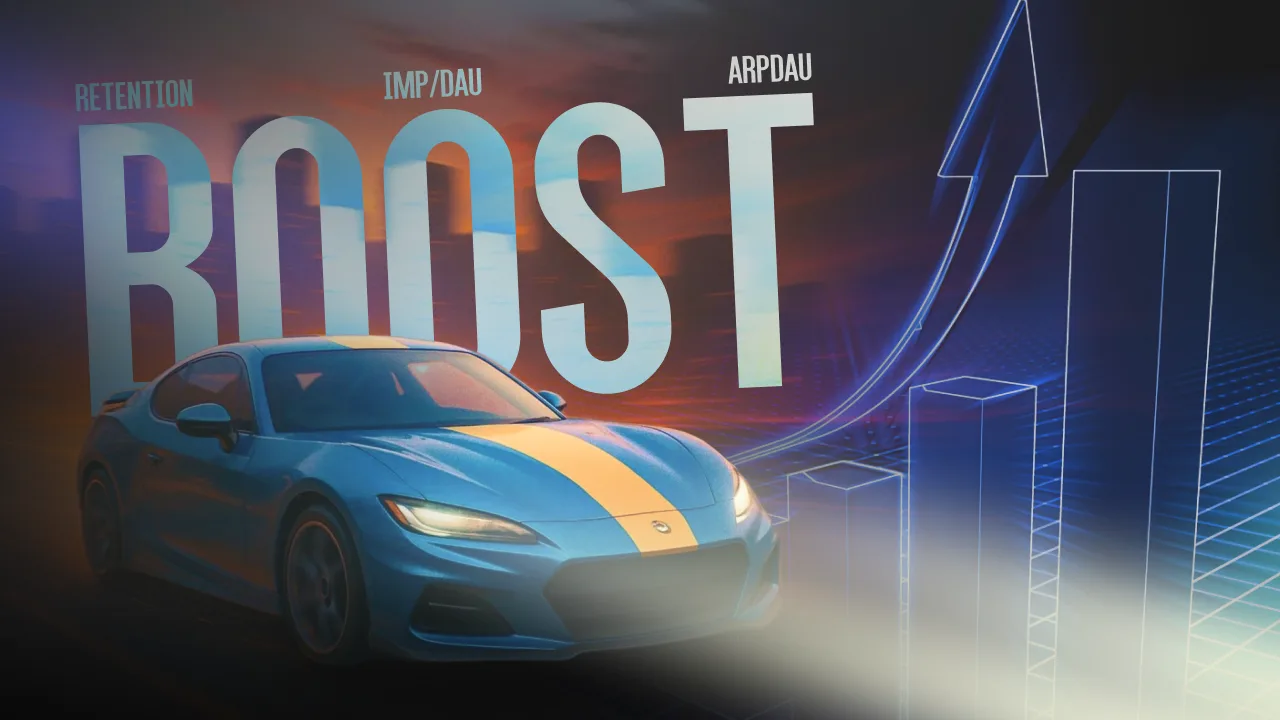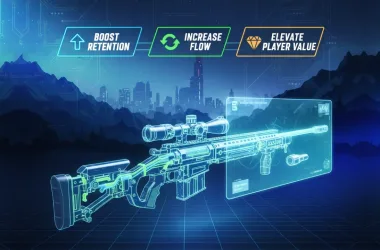Practical notes from the CAS.AI team.
Post-launch, many racing games plateau for the same reasons: the run feels predictable, vehicles don’t signal real progress, and the economy doesn’t invite players back tomorrow. This is a practical blueprint for racing game growth after launch—it blends universal principles with field ranges we’ve observed so you can lift D1/D7, imp/DAU, and ARPDAU without rebuilding the whole game.
For additional context on mobile retention and monetization, see
GameAnalytics’ blog.
Industry ranges we’ve seen
- Career modes can suppress retention by roughly −17–25% even when “easier”.
- Time-limited events (TLEs) often add +5–6% to races and ad revenue but fade without deeper progression.
- Multiplayer can sit near ~0.1% of races in casual-leaning titles, while iOS subscriptions may reach ~20% of IAP yet rarely anchor the core loop.
1) Make every run eventful
If the run is flat, the meta won’t rescue it. Your first wins come from injecting small, readable surprises inside the race. Short-lived transformers (e.g., a 10–20s “bike mode” with a narrower hitbox), track punctuation (ramps, lane-split corridors, moving bottlenecks), and reactive hazards (falling objects, patrol helicopters, timed obstacles) create decision density without bloating scope. The result is longer, more memorable attempts and a natural lift to races per session and imp/DAU—gains that outlive any weekend event.
2) Turn vehicles into true progression, not skins
Progress should be felt on the asphalt. Introduce vehicle classes (C/B/A) with deeper upgrade ceilings and occasional class-gated routes. Prioritize meaningful stats—acceleration bands, braking distance, and vehicle width (narrow bodies thread traffic better). Slightly lowering the baseline of the starter vehicle makes early upgrades tangible. When the default unit isn’t a secret best-in-class, players convert sooner, ownership distribution normalizes, and long-term goals become clear.
3) Give each mode its own economy
One currency rarely fits all motivations. Map rewards to behaviors so players circulate across modes for different reasons. Free Ride can fuel soft currency and common parts (low pressure, high volume). Competitive or online modes can add a rare currency for prestige cosmetics or unique parts. Career/Chapters can grant exclusive blueprints and accelerated XP unavailable elsewhere. This separation preserves value, prevents inflation, and diversifies ARPDAU sources over 30–60 days.
4) Shorter runs, cleaner ad cadence
You don’t need more ads—you need smarter timing. Trim average run length to create natural post-fail interstitials. Place rewarded video at tension peaks (revive after crash, hazard skip, blueprint boost) and improve speed readability (velocity cues, danger telegraphing, lane guidance) so players stay in flow. Protect the first minute from intrusive formats. Teams that paired shorter runs with early vehicle re-pricing saw +5–7% ad revenue through more attempts and cleaner breaks.
5) Daily tasks that are actually worth it
Long or stingy dailies train players to ignore them. Redesign for under five minutes and ensure rewards beat a normal run. Rotate task types—distance, near-misses, clean overtakes—to teach the core and highlight mastery. Keep career-style content optional: a path to exclusives, not a gate to racing. When daily rewards rise just above baseline, habit formation resumes and cohorts carry momentum into D7.
6) Events that build retention, not just spikes
Treat TLEs as on-ramps to the long game, not fireworks. Use a progress ladder with pity protection (guaranteed blueprint thresholds), align routes and modifiers with specific class strengths (e.g., narrow-body advantages), and add event-specific rare-currency sinks to prevent value inflation. This turns short surges into steadier ARPDAU and lifts that persist into D7–D14 instead of collapsing on Monday.
7) Test like a portfolio: quick wins and a vertical slice
Avoid the false choice between tiny tweaks and giant features. Run two tracks in parallel. In 1–2-week sprints, tune run length, early vehicle pricing, upgrade costs, ad cadence, and UI clarity—these are compounding wins. In 3–6 weeks, ship an “eventful race” vertical slice: two to three dynamic elements, one transformer, and one rare-currency sink. Cohort-test before global rollout to de-risk scale. Teams that sustain both tracks lock consistent gains within 60–90 days.
What to measure (and how to read it)
| Metric | Why it matters | Target change / Guardrail |
|---|---|---|
| D1/D3/D7 retention | Habit formation & long-term potential | Seek D7 ↑ with stable D1; big D1↑ but flat D7 = event/UA mismatch |
| Avg. session length | Moment-to-moment quality | Should rise with “eventful” content; watch fatigue indicators |
| Races per session | Core loop stickiness | Upward trend with shorter runs & better cadence |
| imp/DAU & eCPM | Ad supply × price | Keep acceptance high; avoid forced mid-flow spikes |
| ARPDAU (by mode & class) | Monetization health | Diversify sources; track event vs. non-event |
| Time to first upgrade / vehicle | Early progression | Reduce friction; ensure starter nerf isn’t punitive |
| Ownership distribution | Depth of progression | Prevent over-reliance on default unit |
Red flags
- imp/DAU ↑ with races per session ↔︎ → monetizing the same play more aggressively, not growing engagement.
- High D1, weak D7 → the hook is superficial; strengthen core goals and sinks.
- Large gaps across classes → upgrade economy mispriced or content gating too steep.
30/60/90-day action plan
Days 1–30 (Foundations)
- Trim run length and move interstitials to post-fail.
- Improve speed/danger UI; protect the first minute.
- A/B price the first 8–10 vehicles; soften early upgrade costs.
Days 31–60 (Progression & Economy)
- Ship classes with visible stat impact (including width).
- Refactor dailies to <5 minutes with above-run rewards.
- Add the first transformer and one to two dynamic hazards.
Days 61–90 (LiveOps & Scale)
- Launch a retention-focused event with a pity track and class synergy.
- Add a rare-currency sink; extend RV at tension peaks.
- Roll out the eventful-race slice to larger cohorts; lock wins.
Closing thoughts
Racing games win when the race feels alive, vehicles feel like progress, and the economy invites players back tomorrow. You don’t need a rewrite—just deliberate changes to the core moment, progression, and rewards. That’s how more races per session become higher imp/DAU, stronger ARPDAU, and healthier long-term retention. If you’d like a light review of your plan, the CAS.AI team can quietly suggest next steps.
![]()



